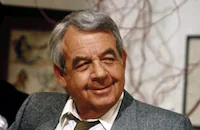Yours, Mine, and Ours

Brief Synopsis
Cast & Crew
Melville Shavelson
Lucille Ball
Henry Fonda
Van Johnson
Tom Bosley
Louise Troy
Film Details
Technical Specs

Synopsis
Naval officer Frank Beardsley, a widower with 10 children, takes a shore job so that he can look after his family; but he finds that they miss their mother and resent his attempts at discipline. Then he begins dating nurse Helen North, a widow with 8 children. With the matchmaking assistance of Beardsley's bachelor friend, Darrell Harrison, Helen and Frank eventually decide to marry, despite the unnerving prospect of such a large family. At first the children resent the marriage, and jealousies among the youngsters create numerous problems in the crowded household; but when Helen's son Phillip begins to hero-worship Frank's eldest boy, Mike, family relations improve and hostilities subside. The bond between parents and children is strengthened by the expectation of Frank and Helen's first baby. When she returns home with the family's 19th child, both sets of children view the new offspring as their own; and they ask to be adopted by their respective stepparents in order that they may all share the same name. With Mike going off to war and Helen's daughter Colleen learning that love also brings responsibilities, the union of the two households is complete.

Director

Melville Shavelson
Cast

Lucille Ball

Henry Fonda

Van Johnson

Tom Bosley

Louise Troy
Ben Murphy
Jennifer Leak
Kevin Burchett
Kimberly Beck
Mitch Vogel
Margot Jane
Eric Shea
Gregory Atkins
Lynnell Atkins
Tim Matthieson
Gil Rogers
Nancy Roth
Gary Goetzman
Suzanne Cupito
Holly O'brien
Michele Tobin
Maralee Foster
Tracy Nelson
Stephanie Oliver
Crew
Howard A. Anderson Co.
James Benjamin
Pete Bernard
Robert F. Blumofe
Dick Bremerkamp
Frank Cardinale
Bob Carroll Jr.
Jordan Cronenweth
Madelyn Davis
Stuart Gilmore
Fred Karlin
Irma Kusely
Mort Lachman
Arthur Lonergan
Louis Nicoletti
James Payne
Pete Peterson
Bill Phillips
Joe Popkin
Renita Reachi
Melville Shavelson
Don Stott
United States Navy
Erika Wernher
Ken Westcott
Charles Wheeler

Videos
Movie Clip




Trailer
Hosted Intro






Film Details
Technical Specs

Articles
Yours, Mine and Ours (1968)
When Henry Fonda heard that Lucille Ball was developing The Beardsley Story as a feature film under the title His, Hers and Theirs, he immediately contacted his former co-star at RKO Studios (They appeared in The Big Street together) and expressed great interest in the male lead. He was quickly hired along with director Melville Shavelson who brought screenwriter Mort Lachman into the project. Lachman was well known as Bob Hope's top writer.
The title of the film was changed to Yours Mine and Our and in the early casting phase of the film, Ball tried to convince the director to cast her two children, Lucie and Desi, Jr. in the picture, a suggestion he refused. Since Ball had a financial stake in Yours Mine and Our and some degree of control, she often clashed with Shavelson on certain aspects of the picture such as ordering retakes of scenes and questioning camera and lighting setups. When things would get particularly tense during production, she would run to Henry Fonda's trailer to ask his advice. There she usually found him doing his crewel work which is a type of embroidery with heavy yarn. Usually Fonda liked to paint on set but it was too much trouble dragging his paintings from location to location so this was the way he occupied his time when he wasn't on call. After listening to her concern about certain scenes being cut by the director and other studio meddling, Fonda assured her things would work out and he returned to his crewel work.
Sure enough, Fonda's advice was right on the money. Yours Mine and Our went on to become the top grossing film for United Artists that year. It also proved to critics and audiences alike that Lucille Ball was not just an inspired comedian but a gifted dramatic actress as well. "There was a big scene in which Hank's kids spike her drink and she becomes drunk," recalls producer Robert F. Blomofe in the biography, Desilu: The Story of Lucille Ball and Desi Arnaz (Quill). "She practically orchestrated it herself. She went from laughter to tears from laughter, back and forth. It was a brilliant tour de force." However, according to Shavelson, "She wouldn't play the scene. She said, 'I can't do that.' It took about an hour of arguing to get her to go out and try it. And it was one of her best performances. She was afraid of combining the drama with the laughter. On the other hand, nobody else could have done it like she did."
Director: Melville Shavelson
Producer: Robert F. Blumofe
Screenplay: Melville Shavelson, Mort Lachman
Cinematography: Charles Wheeler
Music: Fred Karlin
Principle Cast: Lucille Ball (Helen Beardsley), Henry Fonda (Frank Beardsley), Van Johnson (Darrel Harrison), Tom Bosley (Family Doctor), Tim Matheson (Mike Beardsley).
C-112m. Letterboxed.
by Jeff Stafford

Yours, Mine and Ours (1968)
TCM Remembers Van Johnson - Important Schedule Change on TCM In Honor To Salute VAN JOHNSON
The new schedule for the evening of Tuesday, December 23rd will be:
8:00 PM In the Good Old Summertime
9:45 PM A Guy Named Joe
12:30 AM Thirty Seconds Over Tokyo
2:30 AM The Last Time I Saw Paris
4:30 AM Thrill of a Romance
Van Johnson (1916-2008)
Van Johnson, the boyish leading man whose clean cut, All-American appeal made him a top box-office draw for MGM during World War II, died on December 12 in Nyack, New York of natural causes. He was 92.
He was born Charles Van Dell Johnson on August 25, 1916, in Newport, Rhode Island. By his own account, his early childhood wasn't a stable one. His mother abandoned him when he was just three and his Swedish-born father offered little consolation or nurturing while he was growing up. Not surprisingly, Johnson found solace in singing and dancing lessons, and throughout his adolescence, he longed for a life in show business. After graduating high school in 1934, he relocated to New York City and was soon performing as a chorus boy on Broadway in shows such as New Faces of 1936 and eventually as an understudy in Rodgers and Hart's musical, Too Many Girls in 1939.
Johnson eventually made his way to Hollywood and landed an unbilled debut in the film version of Too Many Girls (1940). By 1941, he signed a brief contract with Warner Bros., but it only earned him a lead in a "B" programmer Murder in the Big House (1941); his contract soon expired and he was dropped by the studio. Johnson was on his way back to New York, but as luck would have it - in the truest Hollywood sense - friends Lucille Ball and Desi Arnaz introduced him to Billy Grady, a lead talent scout at MGM, which was currently Ball's new studio. Johnson was signed up and almost immediately MGM had a star on its hands.
It might have been slow going at first, with Johnson playing able support in films such as Dr. Gillespie's New Assistant and The War Against Mrs. Hadley (both 1942). By 1943 the studio capitalized on his broad smile and freckles and starred him in two of the studio's biggest hits: A Guy Named Joe and The Human Comedy. Those two films transformed him into a boxoffice draw with a huge following, particularly among teenage girls. A near fatal car accident that same year only accentuated the loyalty of his fans, and his 4-F status as the result of that accident created an opportunity for him when so many other leading actors of the era (James Stewart, Clark Gable) were off to war. Johnson was quickly promoted as MGM'sleading man in war heroics and sweet romancers on the big screen: The White Cliffs of Dover, Thirty Seconds Over Tokyo (both 1944), Thrill of a Romance, the episodic Week-End at the Waldorf (both 1945), and a musical remake of Libeled Lady entitled Easy to Wed (1946).
Hits though these were, it wasn't until after the war that Johnson began to receive more dramatic parts and better material such as supporting Katharine Hepburn and Spencer Tracy in the political farce State of the Union (1948). other significant roles included the well-modulated noir thriller The Scene of the Crime, the grim war spectacle Battleground (both 1949), the moving domestic drama Invitation (1952) in which he played a man who is paid to marry a woman (Dorothy McGuire) by her father. Before he left MGM, he closed his career out in fine form with the sweeping musical Brigadoon, co-starring Gene Kelly and Cyd Charisse; and the lilting soaper The Last Time I Saw Paris (both 1954) with Elizabeth Taylor.
After he left MGM, the parts that came Johnson's way weren't as varied, but he had his moments in The Caine Mutiny (1954), the beguiling romance drama Miracle in the Rain (1956) with Jane Wyman; and his lead performance in one of the first successful made for-TV-movies The Pied Piper of Hamelin (1957). By the '60s, Johnson returned to the stage, and played the title role in London's West End production of The Music Man. He then returned to Broadway in the drama Come on Strong. He still had a few good supporting parts, most notably as Debbie Reynolds' suitor in Norman Lear's scathing satire on marital differences Divorce American Style (1967); and television welcomed his presence on many popular shows in the '70s and '80s such as Maude, Fantasy Island, The Love Boat and of course Murder She Wrote. There was one last graceful cameo in Woody Allen's The Purple Rose of Cairo (1985), yet for the most remainder of his career, Johnson worked mainly on the dinner theater circuit before retiring from showbiz completely by the mid-90s. He is survived by a daughter, Schuyler.
by Michael T. Toole
TCM Remembers Van Johnson - Important Schedule Change on TCM In Honor To Salute VAN JOHNSON
Quotes
It was a typical wedding: enemies of the bride on the right, enemies of the groom on the left.- Frank Beardsley
You mean he doesn't know about us?- Jean North
Well of course he does darling!- HelenNorth
All of us?- Jean North
Oh mother that's so romantic! You lied to him!- Colleen North
I did not lie to him! I just didn't have the nerve to tell him the whole truth!- Helen North
Trivia
Based upon the real story of Mr. & Mrs. Beardsley.
The real Helen Beardsley appeared on "To Tell the Truth" (1956) where she related her story to the panel.
Helen Beardsley (who wrote the book Who Gets the Drumsticks? on which this was based) died 26 April 2000, aged 70, Healdsburg, California, USA (Parkinson's disease).
Notes
Location scenes filmed in San Francisco. Based on the true story about the Beardsley family of California in the early 1960's. The working title of this film is His, Hers and Theirs.

Miscellaneous Notes
Released in United States Spring April 1968
Film was based on a true story.
Released in United States Spring April 1968














